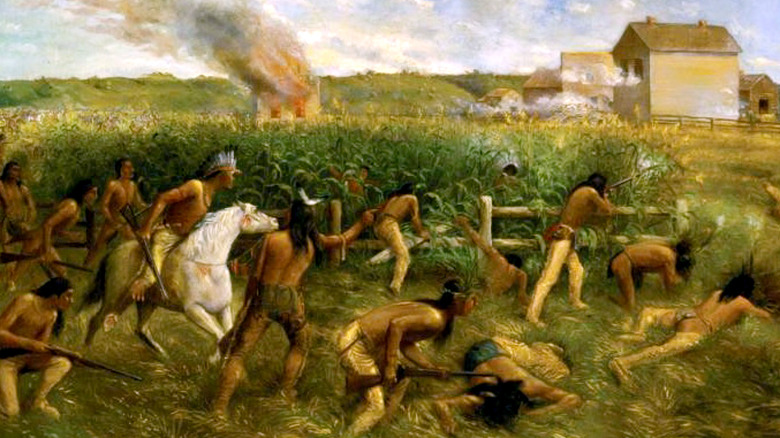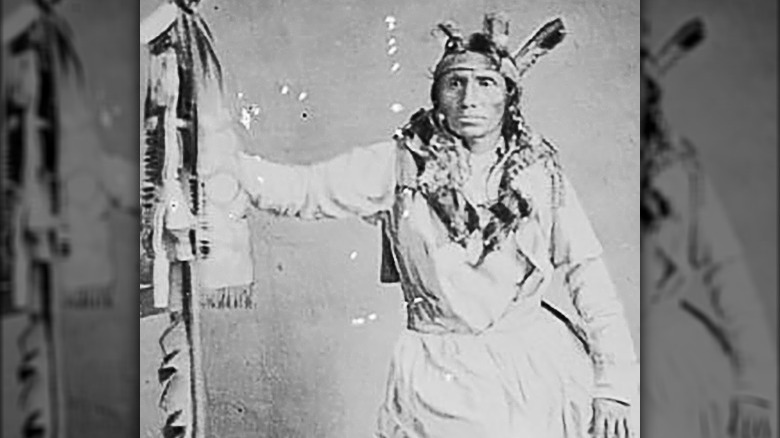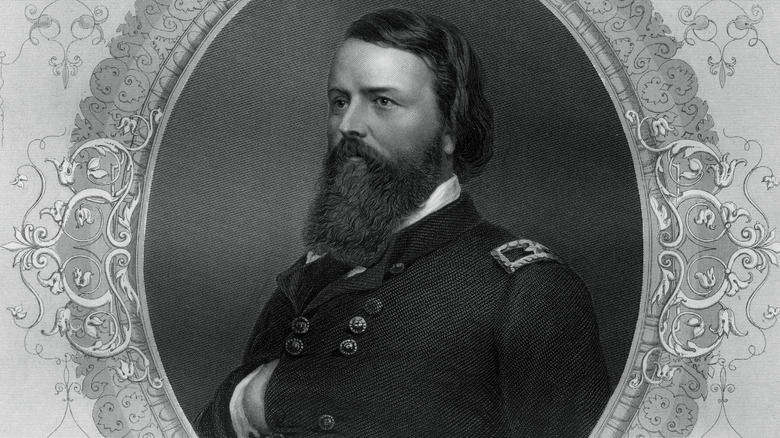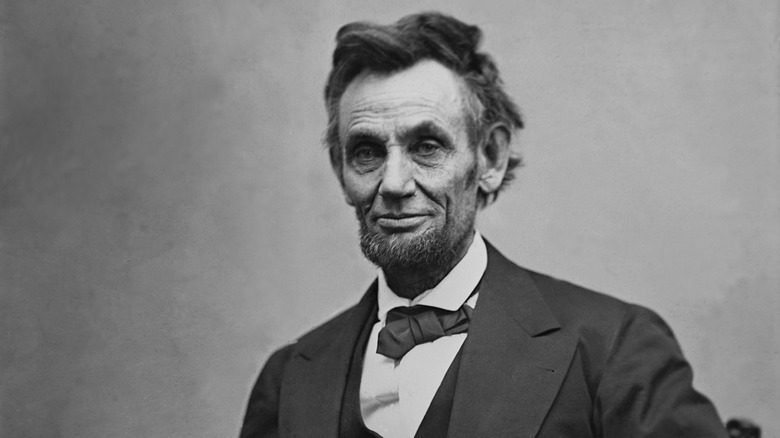The True Story Behind The Execution Of Over 3 Dozen Native Americans In Minnesota
On December 26, 1862, 38 Santee Sioux, also known as Dakota, sang and held each other's hands as U.S. soldiers slipped white muslin hoods over the men's heads, according to The U.S.-Dakota War of 1862 website. The Native Americans, ranging in age from 16 to more than 70 years old, stood together on a giant scaffold especially built for them, per The Winona Daily Republican. A few minutes later, a soldier cut a rope that caused the floor to drop away, and all the prisoners fell through the space and were hanged.
The condemned men were charged with raping and murdering white settlers in Minnesota. In reality, the Santee Sioux, more than 300 of whom were originally given death sentences, were merely trying desperately to hold on to their lands, traditions, and dignity, and had by the summer of 1862 decided the only way to do that was to fight back, per History. For six weeks, violence erupted between Native Americans and settlers, with 650 settlers and Sioux dying in the bloodshed in what would become known as the "Minnesota Uprising," according to another post at History.
Loss of land, corrupt officials, and poor crops
By the late 1840s, white settlers were clamoring for the prime agricultural lands of the Santee Sioux. In 1851 the settlers got their way through two treaties that pushed the four bands making up the Santee Sioux nation onto reservations near the Minnesota River, according to Francis Paul Prucha's 1984 book "The Great Father: The United States Government and the American Indians." The U.S. government pushed the Native Americans to take up farming, but many of the Santee Sioux wanted to continue living as they had before being stuck on reservations. They preferred to "go where they pleased and when they pleased, hunt game wherever they could find it, sell their furs to the traders, and live as they could," Chief Big Eagle, who participated in the war, later recalled, per "The Great Father."
Life on the reservations where the Santee Sioux were pressured to become farmers was untenable. Corrupt government agents and traders treated them horribly. In the summer of 1862, after the Native Americans' crops failed and they were on the verge of starvation, the government agents refused to provide them with food because the agents hadn't received their kickbacks, according to History. One trader, Andrew Myrick, remarked that "so far as I am concerned, if they are hungry let them eat grass," per "The Great Father."
Stolen eggs helped spark the Minnesota Uprising
On August 17, 1862, four young Santee Sioux warriors on their way back from a failed hunting trip stole some eggs from a white settler, and during an ensuing argument, killed five members of the settler's family, according to History. Believing that the whites would quickly retaliate, the Santee Sioux decided war was their only choice and went on the offensive under the command of Taoyatiduta, also known as Little Crow (above), per "The Great Father."
The warriors attacked the Indian Agency headquarters, outlying farms, and the nearby town of New Ulm, per History. Among those they killed was the trader, Myrick. They stuffed grass into his mouth after he died, according to "The Great Father." The warriors also defeated a force of U.S. soldiers sent from nearby Fort Sibley, and took around 200 hostages from their raids, according to The U.S.-Dakota War of 1862. These early successes wouldn't last. While the Sioux ranged across Southern Minnesota raiding with near impunity, a Union general was amid a disastrous battle that would change the course of his career and help end the "Minnesota Uprising."
President Lincoln Sends General John Pope to Minnesota
During the Second Battle of Bull Run (also known as Second Manassas), which took place from August 28 to August 30, 1862, in Virginia, Major General John Pope's indecisiveness and jumbled orders led to a resounding defeat at the hands of the Confederates, with the loss of more than 15,000 Union troops, per Britannica. President Abraham Lincoln relieved him of his command and shipped him off to Minnesota to deal with the Santee Sioux, per History.
Pope tasked Henry Sibley, a former fur trader and Minnesota's first governor, with defeating the Santee Sioux, telling him in a letter that he wanted nothing short of their extermination: "They are to be treated as maniacs or wild beasts, and by no means as people with whom treaties or compromises can be made," he wrote in a letter dated September 28 (per The U.S.-Dakota War of 1862). Sibley had already attained the beginning of this goal on September 23, when he defeated Little Crow and his Santee Sioux warriors at the Battle of Wood Lake, per American Battlefield Trust.
Lincoln commutes many sentences
Just days after the Battle of Wood Lake, a military tribunal headed by Sibley began trying Santee Sioux men alleged to have taken part in the war. In just 10 days, the commission tried 392 prisoners, with 303 sentenced to death and 10 given prison sentences. According to Carol Chomsky, an associate professor at the University of Minnesota Law School quoted by The U.S.-Dakota War of 1862 website, the trials "were conducted unfairly in a variety of ways," including sparse evidence and a biased tribunal. Additionally, the Santee Sioux men had no representation during the trials, proceedings that were held in a foreign language.
Pope wanted a swift hanging, saying that it was "necessary" and would have "a crushing effect" on the rest of the Sioux, per "The Great Father." President Abraham Lincoln didn't agree. He weighed the need to "not act with so much clemency as to encourage another outbreak ... nor with so much severity as to be real cruelty on the other," he later told the U.S. Senate, per Collected Works of Abraham Lincoln. Lincoln had all the trial transcripts sent to him and after reviewing them, pared down the death sentences from 303 to 39 based on whether the men had either participated in "massacres" rather than battles or who had been found guilty of rape, per his message to the U.S. Senate. But with the scant evidence and fast trials, Lincoln's decisions were based on faulty evidence.
Death and the Aftermath
Just before 39 Santee Sioux men were to be hanged in Mankato, Minnesota, on December 26, 1862, Lincoln commuted one of their death sentences to a prison term, reducing their number to 38. But after the Sioux had been executed before a crowd of 4,000 settlers, it was determined that two of them had been killed by mistake, per The U.S.-Dakota War of 1862. One of these victims, Wasicuƞ, had been acquitted but somehow still ended up on the gallows and they hanged another man, Wicaƞḣpi Wastedaƞp, due to a mix-up with his name, according to The U.S.-Dakota War of 1862.
The rest of the Santee Sioux also suffered in the war's aftermath. The people of Minnesota wanted the Native Americans out of the state — the lands the whites had stolen — and the U.S. government agreed to these demands, per "The Great Father." The government revoked the earlier treaties and shipped the rest of the bands to a desolate piece of land in South Dakota, which was then known as the Dakota Territory, according to The U.S.-Dakota War of 1862. In the first year in their new home, more than 200 people died, mostly children.





